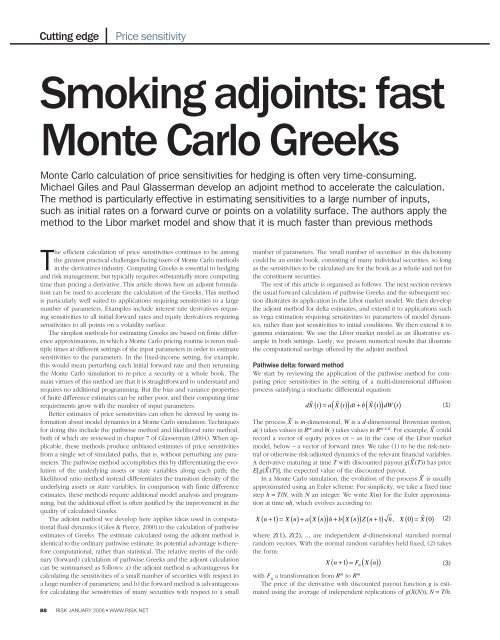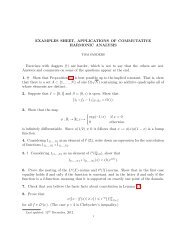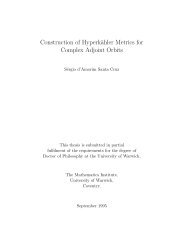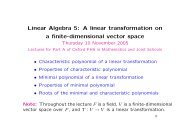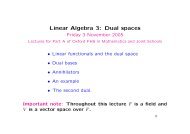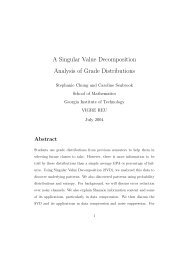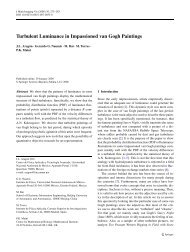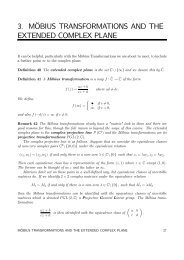Smoking adjoints: fast Monte Carlo Greeks - Mathematical Institute
Smoking adjoints: fast Monte Carlo Greeks - Mathematical Institute
Smoking adjoints: fast Monte Carlo Greeks - Mathematical Institute
Create successful ePaper yourself
Turn your PDF publications into a flip-book with our unique Google optimized e-Paper software.
Cutting edge l<br />
The efficient calculation of price sensitivities continues to be among<br />
the greatest practical challenges facing users of <strong>Monte</strong> <strong>Carlo</strong> methods<br />
in the derivatives industry. Computing <strong>Greeks</strong> is essential to hedging<br />
and risk management, but typically requires substantially more computing<br />
time than pricing a derivative. This article shows how an adjoint formulation<br />
can be used to accelerate the calculation of the <strong>Greeks</strong>. This method<br />
is particularly well suited to applications requiring sensitivities to a large<br />
number of parameters. Examples include interest rate derivatives requiring<br />
sensitivities to all initial forward rates and equity derivatives requiring<br />
sensitivities to all points on a volatility surface.<br />
The simplest methods for estimating <strong>Greeks</strong> are based on finite difference<br />
approximations, in which a <strong>Monte</strong> <strong>Carlo</strong> pricing routine is rerun multiple<br />
times at different settings of the input parameters in order to estimate<br />
sensitivities to the parameters. In the fixed-income setting, for example,<br />
this would mean perturbing each initial forward rate and then rerunning<br />
the <strong>Monte</strong> <strong>Carlo</strong> simulation to re-price a security or a whole book. The<br />
main virtues of this method are that it is straightforward to understand and<br />
requires no additional programming. But the bias and variance properties<br />
of finite difference estimates can be rather poor, and their computing time<br />
requirements grow with the number of input parameters.<br />
Better estimates of price sensitivities can often be derived by using information<br />
about model dynamics in a <strong>Monte</strong> <strong>Carlo</strong> simulation. Techniques<br />
for doing this include the pathwise method and likelihood ratio method,<br />
both of which are reviewed in chapter 7 of Glasserman (2004). When applicable,<br />
these methods produce unbiased estimates of price sensitivities<br />
from a single set of simulated paths, that is, without perturbing any parameters.<br />
The pathwise method accomplishes this by differentiating the evolution<br />
of the underlying assets or state variables along each path; the<br />
likelihood ratio method instead differentiates the transition density of the<br />
underlying assets or state variables. In comparison with finite difference<br />
estimates, these methods require additional model analysis and programming,<br />
but the additional effort is often justified by the improvement in the<br />
quality of calculated <strong>Greeks</strong>.<br />
The adjoint method we develop here applies ideas used in computational<br />
fluid dynamics (Giles & Pierce, 2000) to the calculation of pathwise<br />
estimates of <strong>Greeks</strong>. The estimate calculated using the adjoint method is<br />
identical to the ordinary pathwise estimate; its potential advantage is therefore<br />
computational, rather than statistical. The relative merits of the ordinary<br />
(forward) calculation of pathwise <strong>Greeks</strong> and the adjoint calculation<br />
can be summarised as follows: a) the adjoint method is advantageous for<br />
calculating the sensitivities of a small number of securities with respect to<br />
a large number of parameters; and b) the forward method is advantageous<br />
for calculating the sensitivities of many securities with respect to a small<br />
88 RISK JANUARY 2006 ● WWW.RISK.NET<br />
Price sensitivity<br />
<strong>Smoking</strong> <strong>adjoints</strong>: <strong>fast</strong><br />
<strong>Monte</strong> <strong>Carlo</strong> <strong>Greeks</strong><br />
<strong>Monte</strong> <strong>Carlo</strong> calculation of price sensitivities for hedging is often very time-consuming.<br />
Michael Giles and Paul Glasserman develop an adjoint method to accelerate the calculation.<br />
The method is particularly effective in estimating sensitivities to a large number of inputs,<br />
such as initial rates on a forward curve or points on a volatility surface. The authors apply the<br />
method to the Libor market model and show that it is much <strong>fast</strong>er than previous methods<br />
number of parameters. The ‘small number of securities’ in this dichotomy<br />
could be an entire book, consisting of many individual securities, so long<br />
as the sensitivities to be calculated are for the book as a whole and not for<br />
the constituent securities.<br />
The rest of this article is organised as follows. The next section reviews<br />
the usual forward calculation of pathwise <strong>Greeks</strong> and the subsequent section<br />
illustrates its application in the Libor market model. We then develop<br />
the adjoint method for delta estimates, and extend it to applications such<br />
as vega estimation requiring sensitivities to parameters of model dynamics,<br />
rather than just sensitivities to initial conditions. We then extend it to<br />
gamma estimation. We use the Libor market model as an illustrative example<br />
in both settings. Lastly, we present numerical results that illustrate<br />
the computational savings offered by the adjoint method.<br />
Pathwise delta: forward method<br />
We start by reviewing the application of the pathwise method for computing<br />
price sensitivities in the setting of a multi-dimensional diffusion<br />
process satisfying a stochastic differential equation:<br />
( ) + ( () ) ()<br />
dX̃ t a X̃ t dt b X̃ t dW t<br />
()= ()<br />
The process X ~ is m-dimensional, W is a d-dimensional Brownian motion,<br />
a(·) takes values in R m and b(·) takes values in R m × d . For example, X ~ could<br />
record a vector of equity prices or – as in the case of the Libor market<br />
model, below – a vector of forward rates. We take (1) to be the risk-neutral<br />
or otherwise risk-adjusted dynamics of the relevant financial variables.<br />
A derivative maturing at time T with discounted payout g(X ~ (T)) has price<br />
E[g(X ~ (T)], the expected value of the discounted payout.<br />
In a <strong>Monte</strong> <strong>Carlo</strong> simulation, the evolution of the process X ~ is usually<br />
approximated using an Euler scheme. For simplicity, we take a fixed time<br />
step h = T/N, with N an integer. We write X(n) for the Euler approximation<br />
at time nh, which evolves according to:<br />
( )= ( )+ ( ( ) ) + ( ( ) ) ( + ) ( )= ( )<br />
X n+ 1 X n a X n h b X n Z n 1 h, X 0 X̃<br />
0<br />
where Z(1), Z(2), ... are independent d-dimensional standard normal<br />
random vectors. With the normal random variables held fixed, (2) takes<br />
the form:<br />
( )= n ( ( ) )<br />
X n+ 1 F X n<br />
with F n a transformation from R m to R m .<br />
The price of the derivative with discounted payout function g is estimated<br />
using the average of independent replications of g(X(N)), N = T/h.<br />
(1)<br />
(2)<br />
(3)
Now consider the problem of estimating:<br />
the delta with respect to the jth underlying variable. The pathwise method<br />
estimates this delta using:<br />
∂<br />
g( X̃ ( T)<br />
)<br />
X<br />
the sensitivity of the discounted payout along the path. This is an unbiased<br />
estimate if:<br />
that is, if the derivative and expectation can be interchanged.<br />
Conditions for this interchange are discussed in Glasserman (2004), on<br />
pages 393–395. Convenient sufficient conditions impose some modest restrictions<br />
on the evolution of X ~ and some minimal smoothness on the discounted<br />
payout g, such as a Lipschitz condition. If g is Lipschitz, it is<br />
differentiable almost everywhere and we may write:<br />
Conditions under which X ~ i (T) is in fact differentiable in X~ i (0) are discussed<br />
in Protter (1990), on page 250.<br />
Using the Euler scheme (2), we approximate the pathwise derivative<br />
estimate using:<br />
with:<br />
Thus, in order to evaluate (4), we need to calculate the state sensitivities<br />
∆ ij (N). We simulate their evolution by differentiating (2) to get:<br />
i<br />
( )=∆ ( )+ ∑ ∆ kj ( nh ) + ∑ ∑<br />
∆ n+ 1 n<br />
ij ij<br />
⎡ ∂<br />
⎤<br />
E ⎢ g( X̃ ∂<br />
( T)<br />
) ⎥ = E⎡g X̃ T<br />
⎣⎢<br />
∂ X j( 0) ⎦⎥<br />
∂ X j(<br />
0)<br />
⎣<br />
m<br />
∂<br />
g X̃ T X̃ g( X̃ i T<br />
( T)<br />
) = ∑<br />
X 0 X̃ T X̃<br />
0<br />
∂ ( )<br />
∆ ( n)=<br />
ij<br />
m<br />
∂<br />
X<br />
∂ ( )<br />
m ∂ g( X( N)<br />
)<br />
∑ ∆ ij ( N)<br />
∂ X ( N)<br />
i=<br />
1<br />
∂a<br />
∂x j 0<br />
∂ ( )<br />
j 0<br />
∂ Xi( n)<br />
∂ X ( 0)<br />
k = 1 k<br />
ℓ=<br />
1k<br />
= 1<br />
with a i denoting the ith component of a(X(n)) and b iℓ denoting the (i, ℓ)<br />
component of the b(X(n)).<br />
We can write this as a matrix recursion by letting ∆(n) denote the m ×<br />
m matrix with entries ∆ ij (n). Let D(n) denote the m × m matrix with entries:<br />
a<br />
D n<br />
x h i<br />
ik ( )= ik + ∂<br />
δ +<br />
∂<br />
k<br />
i<br />
j<br />
( ̃ ( ) )<br />
E⎡ ⎣<br />
g X T<br />
∂ ( )<br />
∂ ( )<br />
j i=<br />
1 i<br />
, i, j = 1,...,<br />
m<br />
where δ ik is one if i = k and zero otherwise. The evolution of ∆ can now<br />
be written as:<br />
( )= ( )∆( )<br />
∆ n+ 1 D n n<br />
∂biℓ<br />
Zℓ( n+ 1)<br />
h<br />
∂x<br />
with initial condition ∆(0) = I where I is the m × m identity matrix. The matrix<br />
D(n) is the derivative of the transformation F n in (3). For large m, propagating<br />
this m × m recursion may add substantially to the computational<br />
effort required to simulate the original vector recursion (2).<br />
Libor market model<br />
To help fix ideas, we now specialise to the Libor market model of Brace,<br />
Gatarek & Musiela (1997). Fix a set of m + 1 bond maturities Ti , i = 1, ... ,<br />
m + 1, with spacings Ti + 1 – Ti = δi . Let L ~ i (t) denote the forward Libor rate<br />
d<br />
∑<br />
ℓ=<br />
1<br />
( )<br />
d<br />
k<br />
m<br />
⎤<br />
⎦<br />
∂bi<br />
∂x ∂ ( )<br />
∂ ( )<br />
ℓ<br />
k<br />
( ( ) )<br />
j<br />
∆ ( n)<br />
kj<br />
⎤<br />
⎦<br />
Z n+ 1 h<br />
ℓ<br />
( )<br />
(4)<br />
(5)<br />
1. Structure of the matrix D and its transpose<br />
⎛1<br />
⎞ ⎛1<br />
⎞<br />
⎜<br />
⎜<br />
⎜<br />
D =<br />
⎜<br />
⎜<br />
⎜<br />
⎜<br />
⎜<br />
⎝<br />
⎜<br />
1<br />
1<br />
×<br />
×<br />
×<br />
×<br />
×<br />
×<br />
×<br />
×<br />
×<br />
⎟<br />
⎟<br />
⎟<br />
⎟<br />
⎟<br />
,<br />
⎟<br />
⎟<br />
⎟<br />
× ⎠<br />
⎟<br />
⎜<br />
⎜<br />
⎜<br />
T<br />
D =<br />
⎜<br />
⎜<br />
⎜<br />
⎜<br />
⎜<br />
⎜<br />
⎝<br />
1<br />
1<br />
× ×<br />
×<br />
×<br />
×<br />
×<br />
⎟<br />
⎟<br />
⎟<br />
×<br />
⎟<br />
⎟<br />
× ⎟<br />
⎟<br />
× ⎟<br />
× ⎠<br />
⎟<br />
× is a non-zero entry, blanks are zero<br />
fixed at time t for the interval [T i , T i + 1 ), i = 1, ... , m. Let η(t) denote the<br />
index of the next maturity date as of time t, T η(t) – 1 ≤ t < T η(t) . The arbitrage-free<br />
dynamics of the forward rates take the form:<br />
dL̃ i t<br />
= L̃ i t dt i dW t t Ti i m<br />
L̃ ()<br />
t ( ) µ + σ () ≤ ≤ =<br />
T<br />
, 0 , 1,...,<br />
i<br />
()<br />
()<br />
where W is a d-dimensional standard Brownian motion under a risk-adjusted<br />
measure and:<br />
i σi σ jδ jL̃ j t<br />
µ i Lt ̃<br />
()<br />
( () ) =<br />
+ δ L̃ () t<br />
∑<br />
T<br />
1<br />
Although µ i has an explicit dependence on t through η(t), we suppress<br />
this argument. To keep this example as simple as possible, we take each<br />
σi (a d-vector of volatilities) to be a function of time to maturity:<br />
(6)<br />
as in Glasserman & Zhao (1999). However, the same ideas apply if σi is<br />
itself a function of L ~ σi()= t σi− η()+1<br />
t ( )<br />
(t), as it often would be in trying to match a volatility<br />
skew.<br />
To simulate, we apply an Euler scheme to the logarithms of the forward<br />
rates, rather than the forward rates themselves. This yields:<br />
0<br />
( )= ( ) ( ( ( ) ) −<br />
( ) )<br />
= ( )<br />
Li n+ 1 Li n exp ⎡µ<br />
⎣ i L n<br />
2 ⎤ T<br />
σi / 2 h+ σi<br />
Z n+ 1<br />
⎦<br />
h ,<br />
i η nh ,. ..,m<br />
Once a rate settles at its maturity it remains fixed, so we set L i (n + 1) =<br />
L i (n) if i < η(nh). The computational cost of implementing (7) is minimised<br />
by first evaluating the summations:<br />
i σδ j jLj n<br />
Si( n)=<br />
∑ , i = η(<br />
nh) ,..., m<br />
j= η(<br />
nh)<br />
1+<br />
δ jLj( n)<br />
This then gives µ i = σT iSi and hence the total computational cost is O(m)<br />
per time step.<br />
A simple example of a derivative in this context is a caplet for the interval<br />
[Tm , Tm + 1 ) struck at K. It has a discounted payout:<br />
⎛ m 1 ⎞<br />
⎜∏<br />
0<br />
⎝ 1<br />
⎟ δmmax<br />
, L̃ m( Tm)−K δ L̃ T ⎠<br />
i=<br />
0 + ( )<br />
i i i<br />
j= η()<br />
t<br />
{ }<br />
We can express this as a function of L ~ (Tm ) (rather than L ~ (Ti ), i = 1, ... , m)<br />
by freezing L ~ i (t) at L~ i (Ti ) for t > Ti . It is convenient to include the maturities<br />
Ti among the simulated dates of the Euler scheme, introducing unequal<br />
step sizes if necessary.<br />
Glasserman & Zhao (1999) develop (and rigorously justify) the application<br />
of the pathwise method in this setting. Their application includes<br />
the evolution of the derivatives:<br />
( )<br />
j j<br />
(7)<br />
(8)<br />
WWW.RISK.NET ● JANUARY 2006 RISK 89
Cutting edge l<br />
which can be found by differentiating (7). In the notation of (5), the matrix<br />
D(n) has the structure shown in figure 1, with diagonal entries:<br />
and, for j ≠ i:<br />
∆ ( n)=<br />
ij<br />
Dii ( n)=<br />
Li( n+<br />
) Li n i ih<br />
Li( n)<br />
iLi n<br />
+<br />
⎧1<br />
⎪<br />
2<br />
⎨ 1 ( + 1)<br />
σ δ<br />
⎪<br />
2<br />
⎩⎪<br />
( 1+<br />
δ ( ) )<br />
⎧<br />
T<br />
Li n+ 1 σi σ jδ jh<br />
⎪<br />
2<br />
Dij ( n)=<br />
⎨ ( 1+<br />
δ jLj( n)<br />
)<br />
⎪<br />
⎩⎪<br />
0<br />
The efficient implementation used in the numerical results of Glasserman<br />
& Zhao (1999) uses ∆ ij (n + 1) = ∆ ij (n) for i < η(nh), while for i ≥η(nh):<br />
( )<br />
( )<br />
Lin+ 1<br />
∆ ij ( n + 1)=<br />
∆ ( n)+ L ( n+<br />
1)<br />
σ<br />
L n<br />
i<br />
∂ Li( n)<br />
∂ L ( 0)<br />
j<br />
( )<br />
, i = 1,..., m, j = 1,...,<br />
i<br />
i j η nh<br />
> ≥ ( )<br />
otherwise<br />
σδ k kh∆ kj(<br />
n)<br />
( 1+<br />
δkLk(<br />
n)<br />
)<br />
T<br />
ij i i ∑ i<br />
2<br />
k η nh<br />
= ( )<br />
i η nh<br />
< ( )<br />
η( )<br />
i ≥ nh<br />
The summations on the right can be computed at a cost that is O(m) for<br />
each j, and hence the total computational cost per time step is O(m 2 ) rather<br />
than the O(m 3 ) cost of implementing (5) in general.<br />
Despite this, the number of forward rates m in the Libor market model<br />
can easily be 20–80, making the numerical evaluation of ∆ ij (n) rather costly.<br />
To get around this problem, Glasserman & Zhao (1999) proposed <strong>fast</strong>er<br />
approximations to (5). The adjoint method in the next section can achieve<br />
computational savings without introducing any approximation beyond that<br />
already present in the Euler scheme.<br />
90 RISK JANUARY 2006 ● WWW.RISK.NET<br />
Price sensitivity<br />
2. Data flow showing relationship between<br />
forward and adjoint calculations<br />
X(0) X(1)<br />
V(0) V(1)<br />
X(N – 1) X(N)<br />
D(0) D(1) D(N – 1)<br />
...<br />
...<br />
V(N – 1) V(N)<br />
g, ∂g/∂X<br />
Guidelines for the submission of technical articles<br />
Risk welcomes the submission of technical articles on topics relevant to our<br />
readership. Core areas include market and credit risk measurement and management,<br />
the pricing and hedging of derivatives and/or structured securities, and<br />
the theoretical modelling and empirical observation of markets and portfolios.<br />
This list is not an exhaustive one.<br />
The most important publication criteria are originality, exclusivity and relevance<br />
– we attempt to strike a balance between these. Given that Risk technical<br />
articles are shorter than those in dedicated academic journals, clarity of<br />
exposition is another yardstick for publication. Once received by the technical<br />
editor and his team, submissions are logged, and checked against the criteria<br />
above. Articles that fail to meet the criteria are rejected at this stage.<br />
Articles are then sent to one or more anonymous referees for peer review. Our<br />
referees are drawn from the research groups, risk management departments and<br />
trading desks of major financial institutions, in addition to academia. Many have<br />
already published articles in Risk. Depending on the feedback from referees, the<br />
Pathwise delta: adjoint method<br />
Consider again the general setting of (1) and (2) and write ∂g/∂X(0) for<br />
the row vector of derivatives of g(X(N)) with respect to the elements of<br />
X(0). With (4) and (5), we can write this as:<br />
∂g<br />
X 0<br />
∂g<br />
∂ ( ) = ∆( N)<br />
∂ X( N)<br />
∂g<br />
= D( N −1)<br />
D( N − 2) ⋯D(<br />
0)∆( 0)<br />
∂ X( N) T<br />
= V ( 0) ∆( 0)<br />
where V(0) can be calculated recursively using:<br />
T<br />
( )= ( ) ( + ) ( )=<br />
V n D n V n 1, V N<br />
⎛ ∂g<br />
⎞<br />
⎜<br />
⎝ X N<br />
⎟<br />
⎠<br />
∂ ( )<br />
(9)<br />
(10)<br />
The key point is that the adjoint relation (10) is a vector recursion whereas<br />
(5) is a matrix recursion. Thus, rather than update m 2 variables at each<br />
time step, it suffices to update the m entries of the adjoint variables V(n).<br />
This can represent a substantial saving.<br />
The adjoint method accomplishes this by fixing the payout g in the initialisation<br />
of V(N), whereas the forward method allows calculation of pathwise<br />
deltas for multiple payouts once the ∆(n) matrices have been<br />
simulated. Thus, the adjoint method is beneficial if we are interested in<br />
calculating sensitivities of a single function g with respect to multiple<br />
changes in the initial condition X(0) – for example, if we need sensitivities<br />
with respect to each X i (0). The function g need not be associated with<br />
an individual security; it could be the value of an entire portfolio.<br />
Equation (10) is a discrete adjoint to equation (5) in the same way that<br />
the differential equation –dv/dt = A T v is the adjoint counterpart to du/dt =<br />
Au, where u and v are in R m and A is in R m × m . The terminology ‘discrete<br />
adjoint’ is used in computational engineering (Giles & Pierce, 2000), but<br />
in the computational finance context it might also be referred to as a ‘backward’<br />
counterpart to the original forward pathwise sensitivity calculation<br />
since the adjoint recursion in (10) runs backward in time, starting at V(N)<br />
and working recursively back to V(0). To implement it, we need to store<br />
the vectors X(0), ... , X(N) as we simulate forward in time so that we can<br />
evaluate the matrices D(N – 1), ... , D(0) as we work backward as illustrated<br />
in figure 2. This introduces some additional storage requirements,<br />
but these requirements are relatively minor because it suffices to store just<br />
the current path. The final calculation V(0) T ∆(0) produces exactly the same<br />
result as the forward calculations (4)–(5), but it does so with O(Nm 2 ) operations<br />
rather than O(Nm 3 ) operations.<br />
To help fix ideas, we unravel the adjoint calculation in the setting of<br />
the Libor market model. After initialising V(N) according to (10), we set<br />
technical editor makes a decision to reject or accept the submitted article. His decision<br />
is final.<br />
We also welcome the submission of brief communications. These are also<br />
peer-reviewed contributions to Risk but the process is less formal than for fulllength<br />
technical articles. Typically, brief communications address an extension<br />
or implementation issue arising from a full-length article that, while satisfying<br />
our originality, exclusivity and relevance requirements, does not deserve fulllength<br />
treatment.<br />
Submissions should be sent to the technical team at technical@<br />
incisivemedia.com. The preferred format is MS Word, although Adobe PDFs are<br />
acceptable. The maximum recommended length for articles is 3,500 words, and<br />
for brief communications 1,000 words, with some allowance for charts and/or formulas.<br />
We expect all articles and communications to contain references to previous<br />
literature. We reserve the right to cut accepted articles to satisfy production<br />
considerations. Authors should allow four to eight weeks for the refereeing process.<br />
T
3. Structure of the matrix B and its transpose<br />
⎛<br />
⎞ ⎛<br />
⎜<br />
⎜<br />
⎜<br />
B =<br />
⎜<br />
⎜<br />
×<br />
⎜ ×<br />
⎜<br />
⎜ ×<br />
⎝<br />
⎜ ×<br />
×<br />
×<br />
×<br />
×<br />
× ×<br />
⎟<br />
⎟<br />
⎟<br />
⎟<br />
⎟<br />
,<br />
⎟<br />
⎟<br />
⎟<br />
⎠<br />
⎟<br />
⎜<br />
⎜<br />
⎜<br />
T<br />
B =<br />
⎜<br />
⎜<br />
⎜<br />
⎜<br />
⎜<br />
⎝<br />
⎜<br />
× is a non-zero entry, blanks are zero<br />
V i (n) = V i (n + 1) for i < η(nh) while for i ≥η(nh):<br />
( ) ( + )<br />
( )<br />
Li n+ 1 Vi n 1<br />
Vi( n)=<br />
+<br />
L n<br />
i<br />
The summations on the right can be computed at a cost that is O(m),<br />
so the total cost per time step is O(m), which is better than in the general<br />
case.<br />
This is an example of a general feature of adjoint methods; whenever<br />
there is a particularly efficient way of implementing the original calculation<br />
there is also an efficient implementation of the adjoint calculation.<br />
This comes from a general result in the theory of algorithmic differentiation<br />
(Griewank, 2000), proving that the computational complexity of the<br />
adjoint calculation is no more than four times greater than the complexity<br />
of the original algorithm. There are various tools available for the automatic<br />
generation of efficient adjoint implementations, given an<br />
implementation of the original algorithm in C or C++ (see Automatic Differentiation<br />
website, www.autodiff.org).<br />
In practical implementations, the payout evaluation may be performed<br />
by separate code or scripts to that used to perform the <strong>Monte</strong> <strong>Carlo</strong> path<br />
calculations. In such cases, it may be inconvenient or impractical to differentiate<br />
these to calculate ∂g/∂X(T) and a more pragmatic approach may<br />
be to use finite differences to approximate ∂g/∂X(T) and then use this to<br />
initialise the adjoint pathwise calculation.<br />
Pathwise vegas<br />
The previous section considers only the case of pathwise deltas, but similar<br />
ideas apply in calculating sensitivities to volatility parameters. The<br />
key distinction is that volatility parameters affect the evolution equation<br />
(3), and not just its initial conditions. Indeed, although we focus on vega,<br />
the same ideas apply to other parameters of the dynamics of the underlying<br />
process.<br />
To keep the discussion generic, let θ denote a parameter of F n in (3).<br />
For example, θ could parameterise an entire volatility surface or it could<br />
be the volatility of an individual rate at a specific date. The pathwise estimate<br />
of sensitivity to θ is:<br />
∂ ( )<br />
∂ ( )<br />
∂<br />
∂ =<br />
m g ∂g<br />
XiN ∑<br />
θ X N ∂θ<br />
i=<br />
1<br />
T m σi δih<br />
2 ∑<br />
( 1+<br />
δiLi(<br />
n)<br />
) j= i<br />
If we write Θ(n) for the vector ∂X(n)/∂θ, we get:<br />
Fn<br />
Fn Θ( n + )= X n Θ n<br />
X<br />
X n<br />
DnΘ n Bn<br />
∂<br />
( ( ) ) ( )+<br />
∂<br />
∂<br />
1 , θ<br />
∂θ<br />
( ) , θ<br />
= ( ) ( )+ ( )<br />
i<br />
L n+ 1 V<br />
( )<br />
(11)<br />
with initial conditions Θ(0) = 0. The sensitivity to θ can then be evaluated<br />
as:<br />
j<br />
× × × × ⎞<br />
× ×<br />
×<br />
× ⎟<br />
⎟<br />
× ⎟<br />
×<br />
⎟<br />
⎟<br />
⎟<br />
⎟<br />
⎟<br />
⎠<br />
⎟<br />
( )<br />
j<br />
( )<br />
n + 1 σ j<br />
∂<br />
∂ =<br />
g ∂g<br />
θ X N<br />
∂g<br />
=<br />
X N<br />
where V(n) is the same vector of adjoint variables defined by (10).<br />
In applying these ideas to the Libor market model, B becomes a matrix,<br />
with each column corresponding to a different element of the initial<br />
volatility vector σ j (0). The derivative of the ith element of F n (X n ) with respect<br />
to σ j (nh) is:<br />
∂( )<br />
∂ ( ) =<br />
Fn<br />
i<br />
σ nh<br />
where Si is as defined in (8). This has a similar structure to that of the matrix<br />
D in figure 1, except for the leading diagonal elements, which are now<br />
zero. However, the matrix B is the derivative of Fn (Xn ) with respect to the<br />
initial volatilities σj (0), so given the definition (6), the entries in the matrix<br />
B are offset so that it has the structure shown in figure 3.<br />
From (12), the column vector of vega sensitivities is equal to:<br />
T<br />
⎛ ∂ ⎞ N −1<br />
g<br />
T<br />
⎜ ⎟ = ∑ Bn ( ) Vn ( + 1)<br />
⎝ σ 0 ⎠<br />
The ith element of the product B(n) T V(n + 1) is zero except for 1 ≤ i ≤<br />
N – η(nh) + 1, for which it has the value:<br />
where i* ≡ i + η(nh) – 1. The summations on the right for the different values<br />
of i* are exactly the same summations performed in the efficient implementation<br />
of the adjoint calculation described in the previous section.<br />
Hence, the computational cost is O(m) per time step.<br />
Pathwise gamma<br />
The second-order sensitivity of g to changes in X(0) is:<br />
where:<br />
∂ (<br />
Θ(<br />
N)<br />
)<br />
∂ (<br />
{ B( N −1)+<br />
D( N −1)<br />
B( N − 2)+ ... + D( N −2)<br />
... D()<br />
1 B(<br />
0)<br />
}<br />
)<br />
N −1<br />
∑<br />
= V n+ 1 B n<br />
n=<br />
0<br />
j<br />
T<br />
( ) ( )<br />
⎧ Li( n+ 1)<br />
σδ i iLi( n) h<br />
⎪<br />
⎪<br />
1+<br />
δiLi(<br />
n)<br />
⎪<br />
⎪<br />
+ ( Sh i − σih+<br />
Z( n+ 1) h)<br />
Lin+ 1<br />
⎪ Li( n+ 1)<br />
σδ i jLj( n) h<br />
⎨<br />
⎪ 1+<br />
δ jLj( n)<br />
⎪0<br />
⎪<br />
⎪<br />
⎪<br />
⎩<br />
⎪<br />
( S * h− σ * h+ Z( n+ 1) h L n V n<br />
i i ) * ( + 1) * ( + 1)<br />
i i<br />
δ * L * ( n) h m<br />
i i + ∑ L j ( n+ 1) Vj( n+<br />
1) σ j<br />
1+<br />
δ L ( n)<br />
*<br />
∂ g<br />
X 0 X 0<br />
∂ ( )∂ ( ) = ∑<br />
∂ X ( N)<br />
Differentiating (3) twice yields:<br />
2<br />
m<br />
∂ ( )<br />
* *<br />
i i<br />
Γ ijk<br />
∂g<br />
j k i=<br />
1 i<br />
2<br />
Xin j k<br />
∂ ( )<br />
( n)=<br />
∂ X ( 0)∂ X ( 0)<br />
( )= ∑ ( ) ( )+ ∑ ∑ ( )∆ ℓj(<br />
)∆ mk(<br />
)<br />
Γ n+ 1 D n Γ n E n n n<br />
ijk iℓ<br />
ℓjk iℓm ℓ=<br />
1 ℓ=<br />
1m=<br />
1<br />
where D iℓ (n) is as defined previously, and:<br />
+<br />
m<br />
m<br />
j= i<br />
m<br />
m<br />
( N)<br />
∂ g<br />
X N X N<br />
∑∑ ∆ ij ( N)∆ ℓk<br />
( N)<br />
∂ ( )∂ ( )<br />
i=<br />
1 ℓ=<br />
1<br />
n=<br />
0<br />
i<br />
Γ<br />
ijk<br />
2<br />
m<br />
ℓ<br />
( )<br />
i j η nh<br />
= ≥ ( )<br />
> ≥ ( )<br />
i j η nh<br />
otherwise<br />
(13)<br />
WWW.RISK.NET ● JANUARY 2006 RISK 91
Cutting edge l<br />
For a particular index pair (j, k), by defining:<br />
Gin Γ ijk n , Cin Eiℓmn ℓj<br />
n mk n<br />
this may be written as:<br />
E ( n)=<br />
im ℓ<br />
2<br />
∂ Fi( n)<br />
∂ X ( n)∂ X ( n)<br />
ℓ=<br />
1m=<br />
1<br />
( )= ( ) ( )+ ( )<br />
Gn+ 1 DnGn Cn<br />
m<br />
( )= ( ) ( )= ∑ ∑ ( )∆ ( )∆ ( )<br />
This is now in exactly the same form as the vega calculation, and so the<br />
same adjoint approach can be used. Option payouts ordinarily fail to be<br />
twice differentiable, so using (13) requires replacing the true payout g with<br />
a smoothed approximation; this is the subject of current research.<br />
The computational operation count is O(Nm 3 ) for the forward calculation<br />
of L(n) and ∆(n) (and hence D(n) and the vectors C(n) for each index<br />
pair (j, k)) plus O(Nm 2 ) for the backward calculation of the adjoint variables<br />
V(n), followed by an O(Nm 3 ) cost for evaluating the final sums in<br />
(12) for each (j, k). This is again a factor O(m) less expensive than the alternative<br />
approach based on a forward calculation of Γ ijk (n).<br />
Numerical results<br />
Since the adjoint method produces exactly the same sensitivity values as<br />
the forward pathwise approach, the numerical results address the computational<br />
savings given by the adjoint approach applied to the Libor market<br />
model. The calculations are performed using one time step per Libor<br />
interval (that is, the time step h equals the spacing δ i ≡δ, which we take<br />
to be a quarter of a year). We take the initial forward curve to be flat at<br />
5% and all volatilities equal to 20% in a single-factor (d = 1) model. Our<br />
test portfolio consists of options on one-year, two-year, five-year, sevenyear<br />
and 10-year swaps with quarterly payments and swap rates of 4.5%,<br />
5.0% and 5.5%, for a total of 15 swaptions. All swaptions expire in N periods,<br />
with N varying from one to 80.<br />
Figure 4 plots the execution time for the forward and adjoint evaluation<br />
of both deltas and vegas, relative to the cost of simply valuing the<br />
swaption portfolio. The two curves marked with circles compare the forward<br />
and adjoint calculations of all deltas; the curves marked with stars<br />
compare the combined calculations of all deltas and vegas.<br />
As expected, the relative cost of the forward method increases linearly<br />
with N, whereas the relative cost of the adjoint method is approximately<br />
constant. Moreover, adding the vega calculation to the delta calculation<br />
substantially increases the time required using the forward method, but<br />
92 RISK JANUARY 2006 ● WWW.RISK.NET<br />
Price sensitivity<br />
4. Relative CPU cost of forward and adjoint<br />
delta and vega evaluation for a portfolio of<br />
15 swaptions<br />
Relative cost<br />
40<br />
35<br />
30<br />
25<br />
20<br />
15<br />
10<br />
5<br />
Forward delta<br />
Forward delta/vega<br />
Adjoint delta<br />
Adjoint delta/vega<br />
0<br />
0 20 40 60 80 100<br />
Maturity N<br />
ℓ<br />
m<br />
m<br />
this has virtually no impact on the adjoint method because the deltas and<br />
vegas use the same adjoint variables.<br />
It is also interesting to note the actual magnitudes of the costs. For<br />
the forward method, the time required for each delta and vega evaluation<br />
is approximately 10% and 20%, respectively, of the time required<br />
to evaluate the portfolio. This makes the forward method 10–20 times<br />
more efficient than using central differences, indicating a clear superiority<br />
for forward pathwise evaluation compared with finite differences<br />
for applications in which one is interested in the sensitivities of a large<br />
number of different financial products. For the adjoint method, the observation<br />
is that one can obtain the sensitivity of one financial product<br />
(or a portfolio) to any number of input parameters for less than the cost<br />
of the original product evaluation.<br />
The reason for the forward and adjoint methods having much lower<br />
computational cost than one might expect, relative to the original evaluation,<br />
is that in modern microprocessors, division and exponential function<br />
evaluation are 10–20 times more costly than multiplication and addition.<br />
By reusing quantities such as L i (n + 1)/L i (n) and (1 + δ i L i (n)) –1 , which have<br />
already been evaluated in the original calculation, the forward and adjoint<br />
methods can be implemented using only multiplication and addition, making<br />
their execution very rapid.<br />
Conclusions<br />
We have shown how an adjoint formulation can be used to accelerate the<br />
calculation of <strong>Greeks</strong> by <strong>Monte</strong> <strong>Carlo</strong> simulation using the pathwise method.<br />
The adjoint method produces exactly the same value on each simulated<br />
path as would be obtained using a forward implementation of the pathwise<br />
method, but it rearranges the calculations – working backward along<br />
each path – to generate potential computational savings.<br />
The adjoint formulation outperforms a forward implementation in computing<br />
the sensitivity of a small number of outputs to a large number of<br />
inputs. This applies, for example, in a fixed-income setting, in which the<br />
output is the value of a derivatives book and the inputs are points along<br />
the forward curve. We have illustrated the use of the adjoint method in the<br />
setting of the Libor market model and found it to be <strong>fast</strong> – very <strong>fast</strong>. ■<br />
Michael Giles is professor of scientific computing at the Oxford<br />
University Computing Laboratory. Paul Glasserman is the Jack R<br />
Anderson professor at Columbia Business School. The research was<br />
supported in part by NSF grant DMS0410234. Email:<br />
giles@comlab.ox.ac.uk, pg20@columbia.edu,<br />
REFERENCES<br />
Brace A, D Gatarek and M Musiela, 1997<br />
The market model of interest rate dynamics<br />
<strong>Mathematical</strong> Finance 7, pages 127–155<br />
Giles M and N Pierce, 2000<br />
An introduction to the adjoint approach to design<br />
Flow, Turbulence and Control 65, pages 393–415<br />
Glasserman P, 2004<br />
<strong>Monte</strong> <strong>Carlo</strong> methods in financial engineering<br />
Springer-Verlag, New York<br />
Glasserman P and X Zhao, 1999<br />
Fast <strong>Greeks</strong> by simulation in forward Libor models<br />
Journal of Computational Finance 3, pages 5–39<br />
Griewank A, 2000<br />
Evaluating derivatives: principles and techniques of algorithmic differentiation<br />
Society for Industrial and Applied Mathematics<br />
Protter P, 1990<br />
Stochastic integration and differential equations<br />
Springer-Verlag, Berlin


